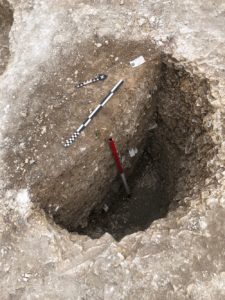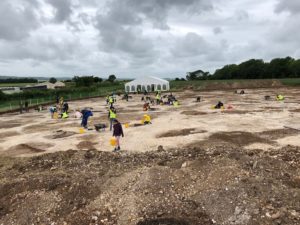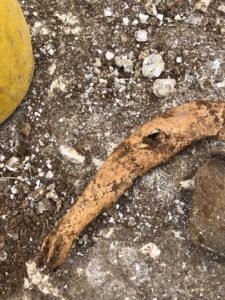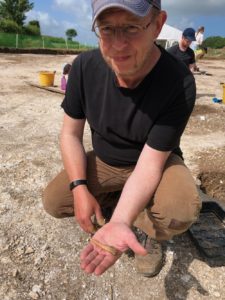Every year, we give over all of December (and usually most of January) to a series called ‘Shadows and Reflections’, in which our contributors share highs, lows and oddments from the past 12 months. Today it’s the turn of Neil Sentance.

Iron Age pit, part excavated
This summer, I indulged a whim I’d had for thirty years, and went on my first archaeological dig. Here in Dorset the deep past is inscribed in its landscape and forever seems at close reach. It is a county of hillforts, henges, round barrows and a neolithic cursus; of Maiden Castle, Pilsdon Pen, Badbury Rings, and Hambledon Hill; and chalk downs and winterbournes and misty pastures that look to have been last cropped by mammoths. It’s hard to live here and not have a fascination with the ancient world, and so for two weeks in June I volunteered on Bournemouth University’s Durotriges ‘Big Dig’ Field School and got an insight into what lies beneath.
I arrive at the site in rolling chalk farmland outside Blandford Forum in bright midsummer sun. The university have been working here for over a decade, slowly uncovering trenches and revealing more of the area’s Iron Age secrets. This year’s trench was earlier stripped of its topsoil, the plough level, to leave a patchwork of brown, organic features amid the white gleam of the limestone bedrock. The brown features indicate sites of potential archaeology. The chalk areas in which they sit are soft, porous, fine-grained, the sedimented calcite shells of ancient sea creatures. Initially, they are an affront to the eyes, and later, hard on the knees.
The students, volunteers and staff, under the aegis of the genial Dr Miles Russell and his colleagues, are hard-working, friendly and committed to their subject. It is heartening to be involved in a collective (uncommercial) enterprise with such dedicated souls. In my day job I’ve long worked alone and to be part of such a team here is a tonic. The break times are punctuated by interested enquiries: ‘What have you got?’ (There are a lot of fans of Detectorists here, as you would hope.) ‘Found anything interesting? Some animal bones, not articulated. Some nice potsherds. Hoping for more when I get back out there’, as roll-ups are smoked, vapes puffed at, tea sipped, sun lotion reapplied. My friend Lorraine, who has been coming here years, is a wellspring of sound advice and good cheer — she’s a typical enthusiast, saying on the first day of the dig that it’s ‘like Christmas morning has arrived at last’. She and I are among the older volunteers, and while most of the students are nineteen-year-olds, there’s a fair smattering of mature scholars too. All generations pitch in.

The trench, early in the dig. The foreground is the spoil heap, which gradually grew into a hillock
Miles explains that the Durotriges tribe were the Iron Age folk who populated Dorset 2,500 years ago. The site indicates possible long settlement. They seemed to co-exist, peaceably, with the Roman invaders well into the new millennium. Romano-British villas and material culture have been found nearby, built by those extending the empire into southwest England from 43 AD. The Durotriges were unusual among Iron Age groups in Britain (as Dr Russell points out, maybe early Dorset exceptionalism). In earlier digs, strange hybridised skeletons have been found: a cow with its legs replaced with those of a horse; a sheep with two heads, one that of a bull protruding from its hind end; a horse with a cow’s horn projecting from its forehead; even a young woman buried on a bed of arranged livestock bones. Are these representations of mythical monsters, akin to those found in the Mediterranean? Miles and his team are still working on it. Additionally, the Durotriges interred their dead in the ground, unlike many British tribes who practised excarnation (laying out defleshed corpses to the elements) or cremation. And this is evidenced here — a number of bodies are uncovered, a bumper crop in fact, to the quiet amazement of the students who work reverentially to free the bones of millennia of dirt. Some pits have tiny glass beads or decorated bowls among the grave goods. In the pit next to mine is a mother and child burial, the remains crouched in a characteristic style, a sight moving to witness, over two thousand years on from their deaths.

Part of horse jaw found in pit
I steadily excavate my small circular storage pit, first a half-section, then the other. It’s hard work, toiling with only a hand trowel in a confined stony space in the baking heat. The hole is about 4 feet in diameter and eventually proves to be about 7 feet deep. Soon the contextual layers are exposed, deeper into the earth, into antiquity, and I slowly begin to disappear below the surface. The crumbling vertical walls are pocked with the marks of the iron adze or pick that they were dug out with. Among the backfill soils, are charred and friable strata, indicating burning, and lumps of chalk, some rounded, most jagged and coarse. This pit may have been used at some point for storing threshed corn, or other less spoilable commodities. Certainly, it was once a midden. Among the tiny fragments of pot and bone are more meaningful finds, unearthed after so long, unseen or touched since by those prehistoric peoples. They inspire something like awe: a complete horse mandible, with its long, worn teeth; glazed bases of broken bowls; iron rings, perhaps part of clothing; and, most remarkably, a bone needle or awl, carved and deposited (or lost) sometime around 100 BC, a tool that fits in the hand perfectly, and that could pierce holes in leather still.

Author with find, an ancient bone needle, probably used in leather-working.
At end of the dig, dusty-white and limb-weary, we all convene at the student bar at Bournemouth University, and confirm the friendships made in the trench this year. And what did I learn from this thirty-year wish fulfilment? What we all know already: companionable human contact, even when hunting for the long gone, is more precious than any shiny metal.
I look forward to next year’s dig, and whatever treasures it yields. The past is always with us.
*
Neil Sentance’s books are ‘Ridge & Furrow’ (Little Toller, 2019) and ‘Water & Sky’ (CBTR/Little Toller, 2014).